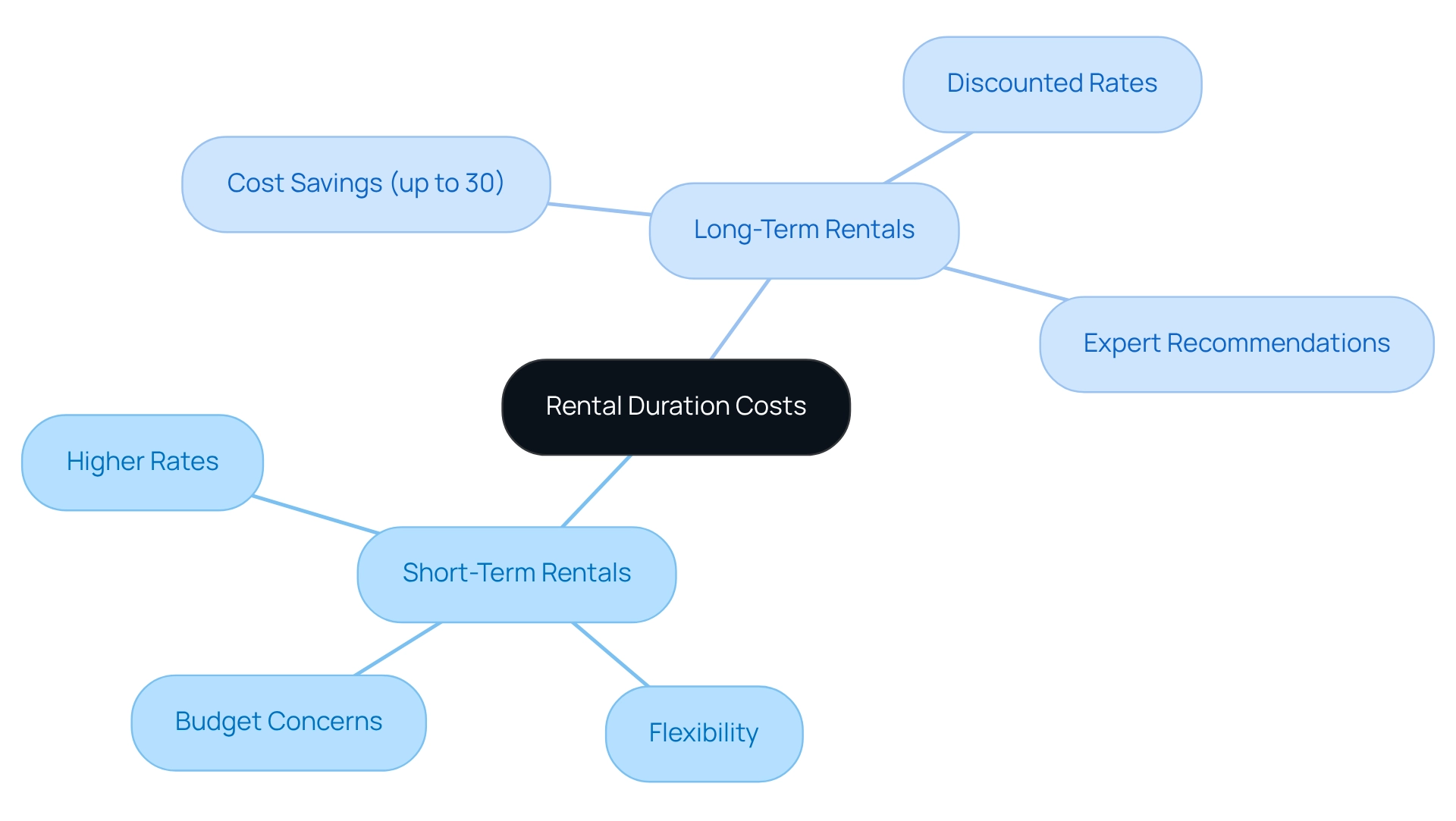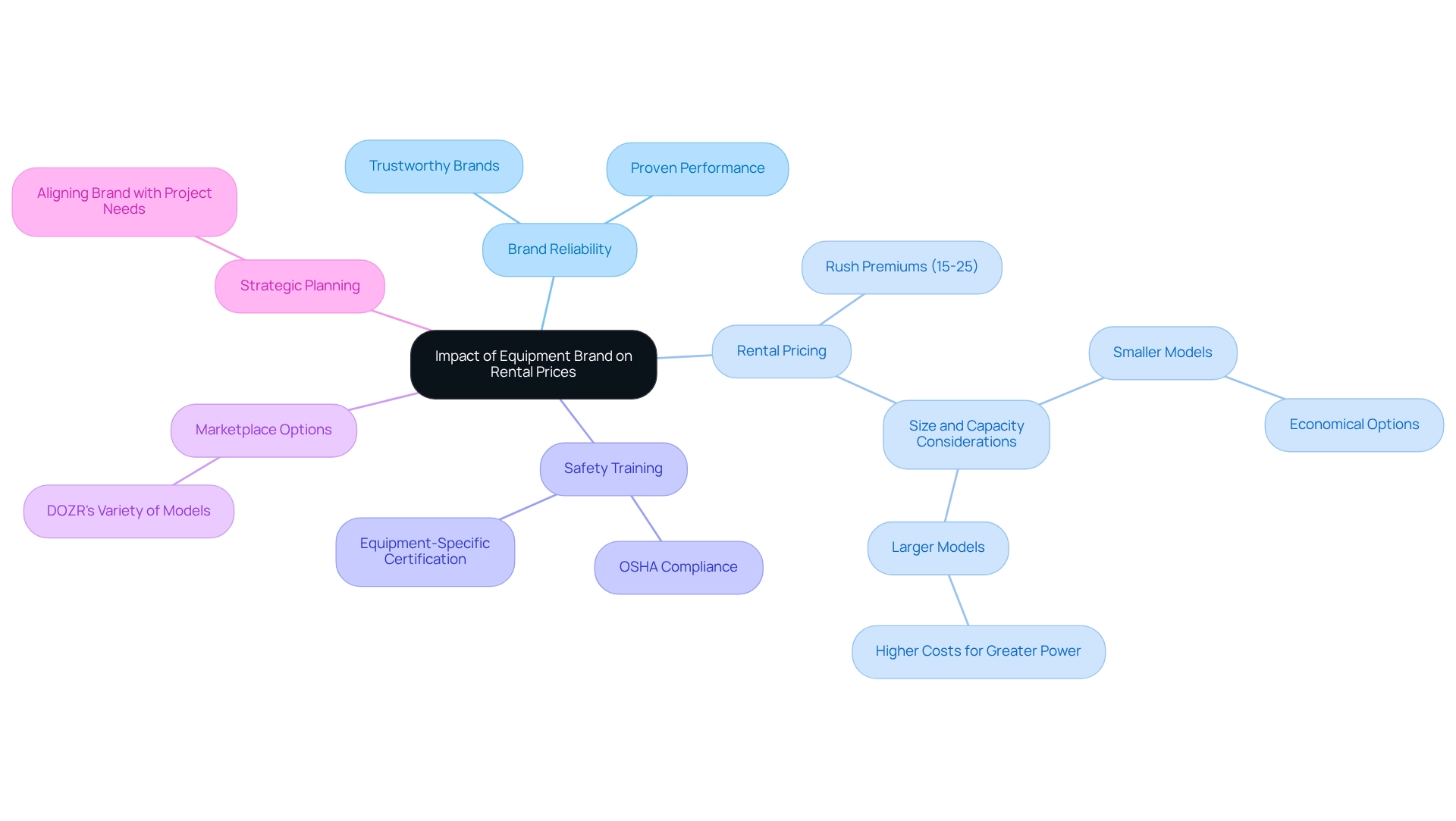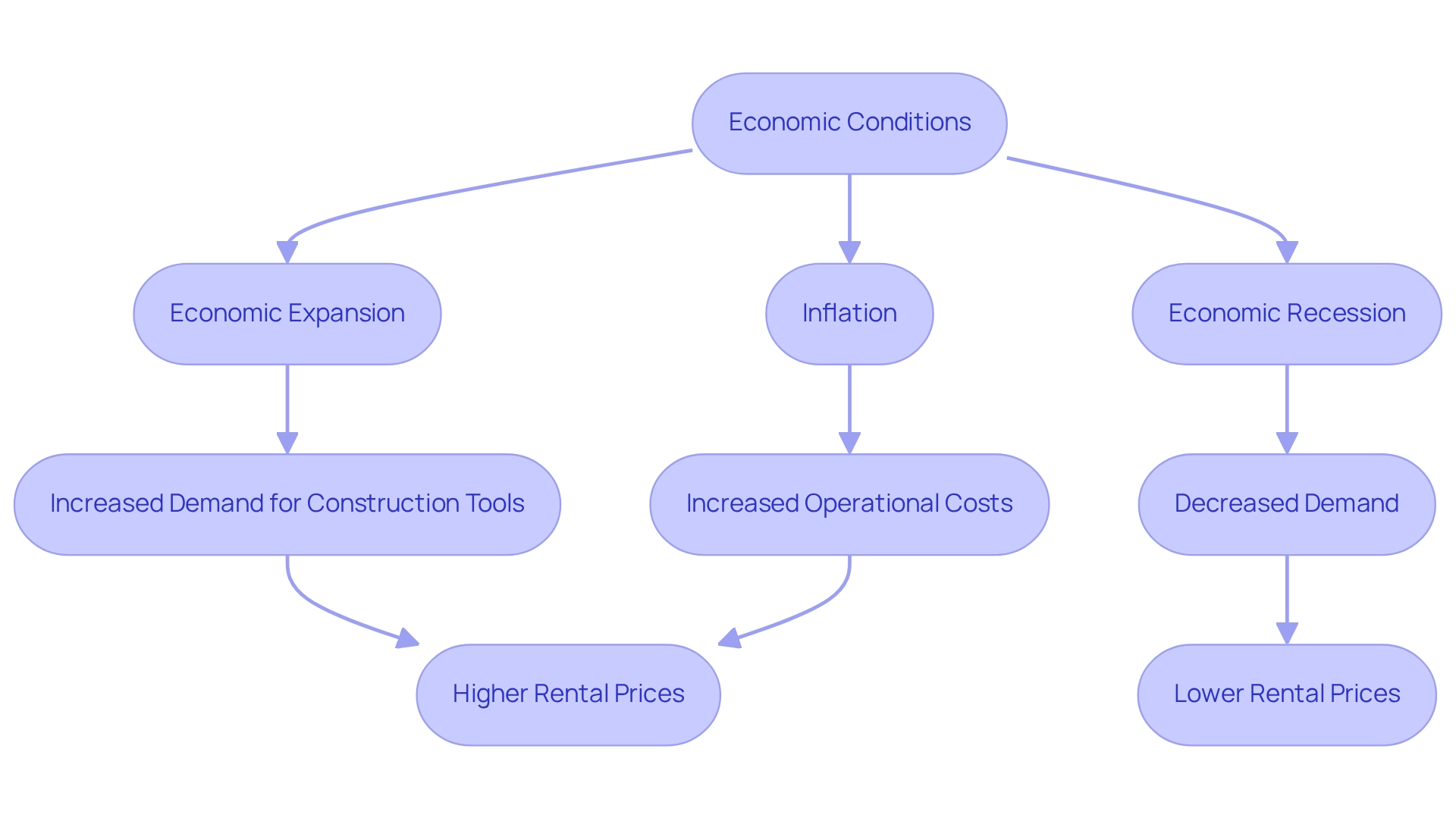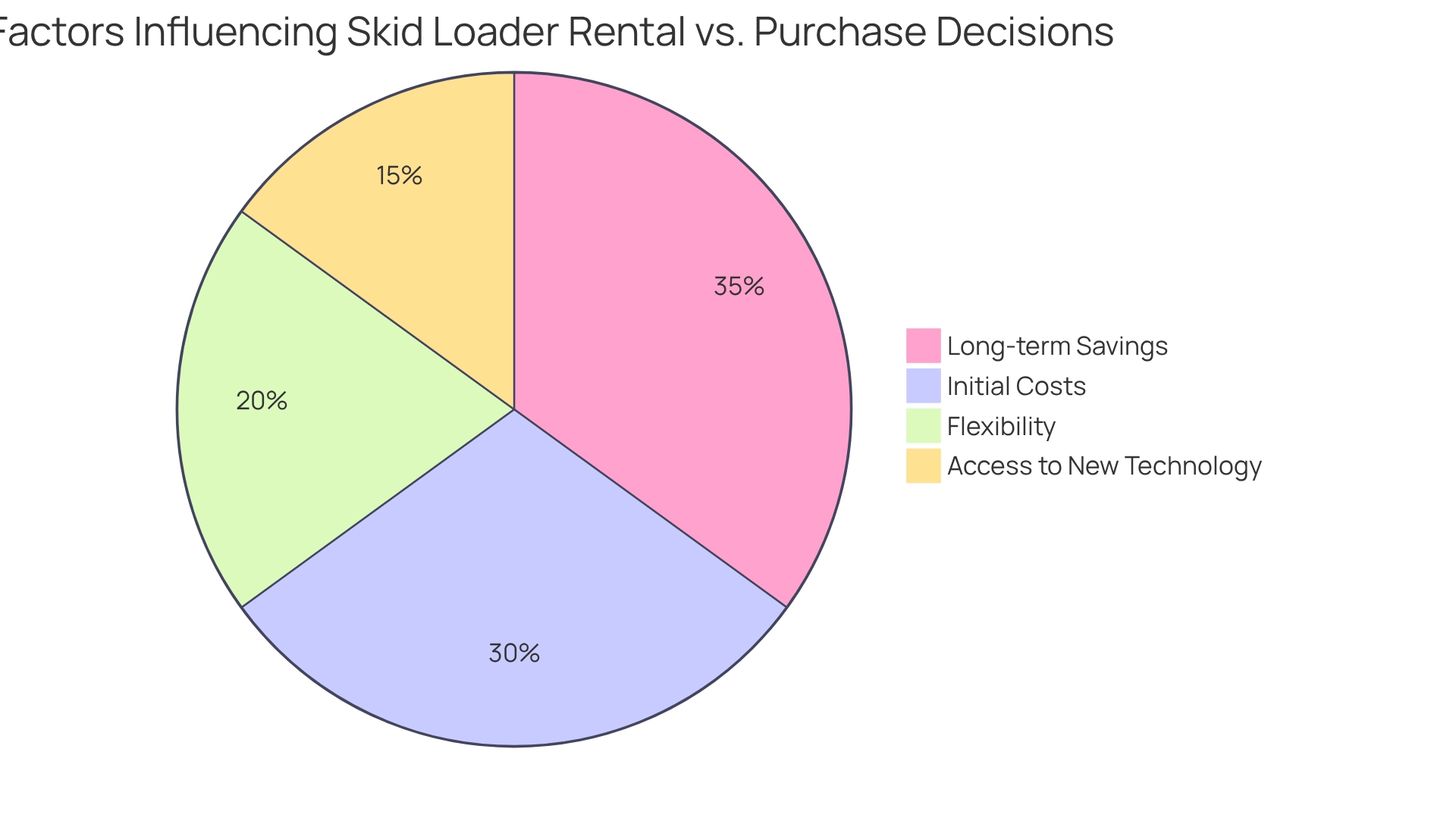Overview
The rental prices of skid loaders are significantly influenced by various factors, including:
- Local demand
- Rental duration
- Brand reputation
- Geographic location
- Delivery costs
- Overall economic conditions
Understanding these elements is crucial, as construction booms can lead to increased prices, while long-term rentals often provide substantial cost savings. Furthermore, the distinction between urban and rural settings plays a pivotal role in shaping rental costs, underscoring the intricate dynamics of the skid loader rental market. This complexity highlights the importance of being well-informed when navigating rental options.
Key Highlights:
- EZ Equipment Rental is recognized as a leading provider of skid loader services in Dallas-Fort Worth, emphasizing quality and reliability.
- The company offers a diverse selection of well-maintained skid loaders and other tools for various industries, ensuring customer satisfaction.
- Local demand for skid loaders affects rental prices, with construction booms leading to increased costs; a CAGR of 11.3% is projected for the skid steer loader market.
- Short-term rentals are typically more expensive than long-term leases, which can save up to 30% in costs for extended projects.
- Choosing the right skid loader size and capacity is crucial for project success, impacting efficiency and safety on construction sites.
- Brand reputation affects rental prices, with established brands often commanding higher rates due to reliability and performance.
- Geographic factors influence rental costs, with urban areas generally having higher prices compared to rural regions.
- Delivery costs, which can range from $50 to $150, should be factored into the overall rental budget to avoid unexpected expenses.
- Economic conditions, including inflation and construction market trends, significantly affect skid loader rental prices.
- Contractors can reduce rental expenses by scheduling extended leasing periods, negotiating with suppliers, and maintaining leased equipment.
Introduction
In the bustling landscape of the Dallas-Fort Worth area, the demand for skid loaders is on the rise, propelled by a thriving construction sector and evolving project needs. EZ Equipment Rental stands out as a leader in this dynamic market, providing a comprehensive range of skid loader rentals tailored to both personal and business requirements.
With a strong emphasis on quality, reliability, and customer satisfaction, the company not only delivers well-maintained equipment but also cultivates partnerships that contribute to successful project outcomes.
As contractors navigate fluctuating rental prices influenced by local demand, rental duration, and geographic factors, understanding the intricacies of the rental market becomes essential for optimizing costs and ensuring project efficiency.
This article explores the critical elements affecting skid loader rental decisions, equipping contractors with the insights necessary to make informed choices in a competitive environment.
EZ Equipment Rental: Premier Skid Loader Rental Services in Dallas-Fort Worth
EZ Equipment Rental stands out as the premier provider of skid loader services in the Dallas-Fort Worth region, recognized for its unwavering commitment to quality and reliability. Offering a diverse selection of skid loaders and other tools tailored to various needs—from construction to landscaping—EZ Equipment Rental guarantees that clients receive machinery that meets their specific requirements, optimizing the leasing process for maximum efficiency.
Leasing from a reputable firm like EZ Equipment Rental ensures access to well-maintained machinery. Their skid loaders, alongside other equipment such as boom lifts and mini excavators, are subjected to regular maintenance, significantly minimizing the risk of breakdowns during critical operations. This dedication to upkeep is complemented by a responsive support team that addresses any issues promptly, reducing downtime and ensuring seamless solutions for your business, while EZ Equipment Rental offers competitive skid loader rental prices and flexible lease terms, making it an appealing option for both personal and business needs. Their focus on customer satisfaction is reflected in their high-quality equipment and service, which are vital for successful project execution.
As the demand for dependable skid loaders continues to rise, EZ Equipment Rental remains the preferred choice for construction project managers in the region, providing not just equipment but a partnership in project success.
Market Demand: How Local Demand Influences Skid Loader Rental Prices
Local demand significantly influences skid loader rental prices in Irving, TX, and the broader DFW Metroplex. In areas experiencing construction booms or increased agricultural activity, the demand for skid loaders rises sharply, which leads to an increase in skid loader rental prices. For example, the USA skid steer loader market is currently witnessing a notable increase in demand for versatile equipment, particularly for debris removal, driven by construction and storage needs. This trend is expected to contribute to a compound annual growth rate (CAGR) of 11.3% in the coming years.
Furthermore, the growing interest in electric and hybrid skid steer loaders aligns with sustainability trends, indicating a shift in market preferences that contractors should take into account. Conversely, in regions with less construction or agricultural activity, leasing prices may stabilize or even decline. Statistics reveal that 84% of construction firms in the U.S. prefer leasing tools instead of purchasing them, underscoring a significant reliance on leasing services. This preference is particularly pronounced in urban areas like Irving, where the demand for skid loaders is considerably higher than in rural regions.
The ongoing construction boom in Texas is also impacting leasing prices. As builders strive to meet project deadlines, competition for available machinery, including boom lifts, mini excavators, and forklifts from EZ Equipment Rental, intensifies, resulting in price fluctuations. For instance, during previous construction booms, skid loader rental prices have seen substantial increases, reflecting the heightened demand. Notably, 99% of contractors expect to rent equipment in the next 12 months, emphasizing the reliance on leasing services in the DFW Metroplex.
Expert insights indicate that understanding these dynamics is essential for contractors to effectively plan their finances and select the optimal time for equipment leasing. As construction economists note, fluctuations in demand can significantly impact leasing rates, making it crucial for project managers to stay informed about local market conditions and the range of machinery available through EZ Equipment Rental at 1307 W Airport Fwy, Irving, TX, (214) 951-7800.
Rental Duration: The Effect of Short-Term vs. Long-Term Rentals on Costs
The length of the leasing period significantly influences overall costs. Short-term accommodations, typically charged daily, often incur higher rates compared to long-term options, which frequently provide discounted weekly or monthly pricing. For example, businesses with steady machinery requirements can benefit from extended leases, as they often lead to significant savings. In fact, long-term leases can lower expenses by as much as 30% compared to short-term alternatives, making them especially advantageous for lengthy endeavors. Extended leases frequently offer reduced prices, emphasizing their affordability.
While temporary accommodations provide the adaptability needed for tasks with uncertain schedules, they may not be the most budget-friendly option for professionals requiring equipment for extended periods. A case study analyzing the drawbacks of leasing skid steers highlights that dependence on provider inventory can result in increased long-term expenses for regular users. This ambiguity in leasing costs complicates budgeting for projects, as builders may face unforeseen expenses. The case study indicates that for companies with ongoing requirements for specific equipment, purchasing may be more beneficial despite the upfront expense, as it offers control over accessibility and costs.
Statistics reveal that many contractors favor long-term leases due to their cost-efficiency, with a notable percentage stating they save money by choosing prolonged leasing durations. Expert guidance emphasizes that understanding the cost variations between short-term and long-term leases is crucial for making informed decisions. Furthermore, the attachments you select may contribute anywhere from $1,000 to $20,000 to your purchase, further affecting overall expenses. Ultimately, contractors should carefully analyze their timelines and equipment needs to determine the most financially viable rental strategy.

Size and Capacity: Choosing the Right Skid Loader for Your Project Needs
Choosing the right size and capacity of a skid loader is crucial for the success of any construction endeavor. Smaller skid loaders excel in tight spaces and are suited for lighter loads, making them ideal for tasks in confined areas. In contrast, larger models, such as the Bobcat S850, boast an impressive 80-inch width and an operating capacity of 3,950 pounds, designed to handle heavier materials and more demanding tasks. With 92 horsepower, this model demonstrates the strength necessary for substantial workloads.
Contractors must thoroughly evaluate their requirements, including load capacity and maneuverability, to select the most appropriate skid loader. This careful evaluation ensures that the equipment can perform efficiently, minimizes downtime, and enhances overall productivity, which is crucial for maintaining safety on construction sites. For example, a consultative method during customer discussions—where open-ended questions about intended use, job site conditions, and budget are addressed—can result in informed choices that align with particular requirements. As highlighted by Construction Equipment Guide, the Bobcat S850 is acknowledged as the skid steer loader with the broadest body in the U.S., making it a leading option for tasks requiring robust capabilities.
Understanding the average load capacities for various skid loader models is essential. While smaller models may suffice for light landscaping tasks, larger endeavors necessitate the robust capabilities of models like the Bobcat S850. Additionally, skid steers are suitable for small chores around farms, especially in tight spaces, showcasing their versatility. By aligning machinery choice with task requirements, builders can significantly impact results, ensuring that the appropriate skid loader is employed for optimal performance and safety.
Furthermore, it is essential to consider how forklifts enhance skid loaders in improving construction efficiency and safety. Forklifts are vital for lifting and transporting heavy materials, making them a valuable addition to any construction site. When assessing leasing alternatives, contractors should also be aware of the skid loader rental prices and the pricing structures for forklifts, as costs can vary based on the type and capacity of the machinery selected. This comprehensive approach to equipment selection not only improves project efficiency but also ensures that safety standards are met.
Make and Model: The Impact of Equipment Brand on Rental Prices
The make and model of a skid loader significantly influence skid loader rental prices. Well-established brands often command higher rates due to their proven reliability and performance. Builders frequently opt for trustworthy brands, recognizing that dependability can lead to fewer malfunctions and enhanced efficiency on-site. While lesser-known brands may offer more competitive pricing, they often fall short in customer assistance and service, which can be vital during critical phases. Insights from equipment leasing specialists indicate that brand reputation not only impacts skid loader rental prices but also influences the overall value perceived by contractors. A case study on skid steer loaders reveals that smaller models from trusted brands tend to be more economical, whereas larger models, despite their increased fees, are essential for tasks requiring greater horsepower and lift capacity. This underscores the importance of aligning brand selection with task requirements and budget constraints.
Furthermore, it is crucial to note that no license is typically required to operate a skid steer in most areas; however, OSHA-compliant safety training and equipment-specific certification are often mandated. This highlights the significance of safety training when borrowing equipment, particularly for construction managers. Statistics indicate that builders may incur rush premiums of 15-25% for last-minute acquisitions, further emphasizing the necessity for strategic planning when selecting equipment.
Additionally, DOZR's marketplace offers an extensive selection of skid steer models for lease, providing builders with various options to meet their specific needs. Ultimately, contractors must carefully evaluate the trade-offs between brand reliability and skid loader rental prices to make informed decisions that align with their project requirements.

Location: How Geographic Factors Affect Skid Loader Rental Costs
Geographic location plays a crucial role in determining skid loader rental prices. Urban areas typically command higher rates due to increased demand and operational expenses. For example, skid loader rental prices for compact track loaders can range from $3,000 to $5,000 per month in urban settings, reflecting competitive market dynamics. Conversely, rural regions often provide more affordable skid loader rental prices, as lower demand and decreased operational expenses contribute to reduced leasing costs.
Builders must consider various expenses when planning for equipment leases. These expenses can encompass:
- Fuel
- Attachments
- Insurance
- Environmental fees
All of which can significantly impact overall rental costs. Additionally, transportation expenses are critical, particularly for workers in remote areas. Transporting supplies to these locations may incur extra fees, which should be factored into the budget. Thus, it is essential for builders to evaluate these geographic factors thoroughly when organizing their tasks, ensuring they account for potential fluctuations in skid loader rental prices based on location.
Industry analysts highlight that understanding these geographic pricing differences is vital for effective budgeting. Kevin Forestell, CEO of DOZR, emphasizes the importance of efficiency in the sector, stating, "We aim to change the standard way equipment is leased." This underscores the necessity for builders to be aware of how urban and rural environments affect skid loader rental prices. By recognizing these factors, builders can make informed decisions that align with their project needs and financial constraints. For instance, in Texas, urban areas may see skid loader prices at the higher end of the spectrum, while rural locations could offer significantly lower rates, providing a compelling incentive for contractors to carefully assess their location.
Delivery Costs: Understanding Additional Fees in Skid Loader Rentals
Delivery expenses are a critical factor in determining skid loader rental prices, as many companies impose additional fees for transporting equipment to and from job sites. These fees can fluctuate significantly based on various elements, including distance, accessibility, and the specific policies of the company. For instance, average delivery costs for skid loader rental prices in Texas typically range from $50 to $150, depending on the location and logistics involved.
To effectively manage project budgets, contractors must proactively inquire about skid loader rental prices during the negotiation of leasing agreements. This approach ensures transparency and helps avert unexpected expenses that could negatively impact profitability. It is advisable to incorporate delivery costs into the overall leasing budget, accounting for every delivery—even if it’s a nominal fee of $10 or $20. As Daniel Kaplan notes, 'Enhanced delivery revenue is an effective method to boost leasing rates,' underscoring the importance of considering all possible expenses in budgeting.
Understanding the variations in delivery costs based on distance is equally crucial. Leasing firms often impose higher skid loader rental prices for longer distances, significantly influencing the total leasing expense. Furthermore, some companies may provide transparent delivery fee structures, enabling customers to anticipate costs more accurately. Incorporating quotes from leasing companies regarding transparency in delivery costs can further highlight the importance of clear communication about fees.
Case studies underscore the necessity of knowing whether leasing firms offer after-hours assistance, which can be vital for clients facing issues beyond standard operating hours. This support not only enhances customer confidence but also contributes to improved financial outcomes for leasing firms, as effective delivery management can lead to better leasing rates.
In conclusion, being aware of delivery expenses and maintaining open communication with leasing companies can facilitate more effective budgeting and create a smoother experience for skid loader leasing.
Market Conditions: Analyzing Economic Factors Affecting Rental Prices
Market conditions significantly influence skid loader rental prices, particularly through economic trends and inflation rates. During periods of economic expansion, the demand for construction tools rises, which frequently results in higher skid loader rental prices. For instance, as North America is projected to secure 27.8% of the worldwide construction equipment market share by 2034, this expansion is likely to drive up skid loader rental prices as contractors compete for available machinery. Conversely, during economic recessions, demand typically declines, leading to reduced skid loader rental prices. Historical data reveal that lease price adjustments often align with economic fluctuations; during the 2008 financial crisis, numerous property management firms lowered their rates to attract clients amid diminished demand.
Inflation also plays a crucial role in shaping equipment leasing costs. Rising inflation rates can elevate operational costs for leasing firms, which may lead to an increase in skid loader rental prices for clients in the form of higher fees. Economists have noted that persistent inflation can create uncertainty in the leasing market, prompting builders to adjust their budgets accordingly.
In Texas, current economic trends indicate a tightening labor market and increasing material costs, which are anticipated to impact leasing prices in 2025. As contractors navigate these conditions, remaining informed about market dynamics will be essential for anticipating changes in skid loader rental prices and effectively planning project budgets. Recent case studies underscore the influence of economic trends on skid loader rental prices. The merger of firms in the machinery leasing sector, such as Texas First Rentals acquiring Rental One, exemplifies a strategic response to shifting market conditions. This trend toward consolidation enables companies to enhance their service offerings and adapt to evolving economic landscapes, ultimately affecting pricing strategies.
Understanding these economic factors is vital for builders aiming to optimize their equipment leasing choices and manage project expenses efficiently.

Cost-Saving Strategies: Tips for Reducing Skid Loader Rental Expenses
To effectively reduce skid loader rental prices, contractors can adopt several strategic approaches. Meticulous scheduling of leasing periods is essential; choosing extended leasing durations typically leads to reduced daily rates, thereby lowering total expenses. Furthermore, combining several rental items can unveil substantial discounts, making it a fiscally wise option. Regular maintenance inspections on leased tools are crucial, as they help prevent damage and avoid incurring extra fees. Notably, 70% of builders prefer renting aerial work platforms due to their high maintenance expenses, which is a concern that similarly relates to skid loader rental prices. This underscores the importance of caring for leased equipment to avoid unforeseen costs.
Engaging in discussions with suppliers can yield better rates, particularly for extended assignments. As Stéphane Hénon, managing director of Loxam, emphasizes, the leasing sector plays a pivotal role in supporting communities and enterprises, making it essential for builders to leverage this relationship for improved terms. Additionally, insights from Ben Garner, vice president of Equipment Depot, suggest that integrating artificial intelligence into rental operations can enhance predictive maintenance, ultimately leading to cost reductions.
By applying these strategies, including examples of professionals who have successfully negotiated rental conditions and practical guidance from financial advisors on effective negotiation techniques, contractors can optimize their rental costs and boost profitability.
Renting vs. Buying: Evaluating the Financial Implications for Skid Loaders
Contractors face critical financial decisions when considering skid loader rental prices in comparison to buying a skid loader. Renting offers considerable benefits, particularly for short-term projects, as skid loader rental prices require lower initial expenses and provide flexibility in equipment choices. This method allows builders to utilize the latest technology without the burden of ownership expenses. Conversely, for tasks that necessitate regular use, acquiring a skid loader can be more cost-effective in the long run by eliminating continuous skid loader rental prices and enabling customization to meet specific operational requirements.
A recent analysis indicates that frequent use of skid steers often makes purchasing more cost-effective, especially when considering the total cost of ownership, which includes maintenance and depreciation. Furthermore, tax deductions for operating costs and depreciation can enhance the financial benefits of ownership for builders. Therefore, contractors should carefully evaluate their project frequency, duration, and overall budget to determine the most advantageous option.
For example, a case study on the evolving equipment leasing industry highlighted that earthmoving machinery, including skid loaders, remains in high demand, underscoring the importance of making informed leasing decisions. Growth trends in the leasing market indicate a shift towards renting, driven by factors like skid loader rental prices, cost savings, access to newer technology, and flexibility. Financial advisors recommend conducting a thorough cost analysis, weighing the benefits of rental flexibility against the long-term savings of ownership. As Josh Nickell, Vice President of the American Rental Association’s equipment segment, aptly noted, "These multi-year issues diminished the optimism that would otherwise exist," reflecting current market conditions that builders must consider.
Ultimately, the decision to rent or purchase should align with the contractor's specific requirements and financial strategy. Contractors should assess criteria such as project duration, frequency of use, and budget constraints to maximize both efficiency and cost-effectiveness in their operations.

Conclusion
The landscape of skid loader rentals in the Dallas-Fort Worth area is shaped by various factors that contractors must navigate to optimize their project outcomes. EZ Equipment Rental emerges as a reliable partner, offering a diverse selection of well-maintained skid loaders and a commitment to customer satisfaction. Understanding local demand, rental duration, equipment size, and brand reputation is crucial for making informed decisions that align with project needs and budget constraints.
Contractors should also be mindful of geographic factors and delivery costs, as these can significantly impact overall rental expenses. Economic conditions further complicate the rental market, with fluctuations in demand and inflation influencing pricing strategies. By implementing cost-saving strategies and evaluating the financial implications of renting versus buying, contractors can enhance their operational efficiency and profitability.
In this competitive environment, staying informed and strategically planning equipment rentals can lead to substantial savings and successful project execution. As the demand for skid loaders continues to rise, leveraging insights and understanding market dynamics will empower contractors to make effective choices that drive project success.
Frequently Asked Questions
What makes EZ Equipment Rental a leading provider of skid loader services in the Dallas-Fort Worth region?
EZ Equipment Rental is recognized for its commitment to quality and reliability, offering a diverse selection of skid loaders and tools tailored to various needs, ensuring clients receive machinery that meets their specific requirements.
How does EZ Equipment Rental ensure the quality of its skid loaders?
EZ Equipment Rental guarantees access to well-maintained machinery, with regular maintenance conducted on their skid loaders and other equipment, significantly reducing the risk of breakdowns during operations.
What types of equipment does EZ Equipment Rental offer besides skid loaders?
In addition to skid loaders, EZ Equipment Rental offers boom lifts, mini excavators, and other tools suitable for construction and landscaping projects.
How do local demand and market conditions affect skid loader rental prices in Irving, TX?
Rental prices increase in areas experiencing construction booms or agricultural activity due to heightened demand for skid loaders. Conversely, prices may stabilize or decline in regions with less activity.
What is the current trend in the skid steer loader market?
The skid steer loader market is witnessing increased demand for versatile equipment, particularly for debris removal, with a projected compound annual growth rate (CAGR) of 11.3% in the coming years.
What percentage of construction firms in the U.S. prefer leasing tools instead of purchasing them?
Statistics reveal that 84% of construction firms in the U.S. prefer leasing tools, highlighting a significant reliance on leasing services.
How do leasing prices fluctuate during construction booms?
During construction booms, competition for available machinery increases, leading to price fluctuations for rentals. Previous booms have seen substantial increases in skid loader rental prices.
What factors should contractors consider when planning for equipment leasing?
Contractors should stay informed about local market conditions, demand fluctuations, and the range of machinery available to effectively plan their finances and select the optimal time for equipment leasing.
How does the length of the leasing period impact overall costs?
Short-term leases, typically charged daily, often incur higher rates compared to long-term options, which frequently provide discounted weekly or monthly pricing. Long-term leases can lower expenses by up to 30%.
What are the potential drawbacks of relying on leasing for equipment?
Dependence on provider inventory can lead to increased long-term expenses for regular users, complicating budgeting for projects due to unforeseen costs associated with leasing.
What should contractors analyze to determine the most financially viable rental strategy?
Contractors should carefully analyze their timelines and equipment needs, considering the cost variations between short-term and long-term leases to make informed decisions.




